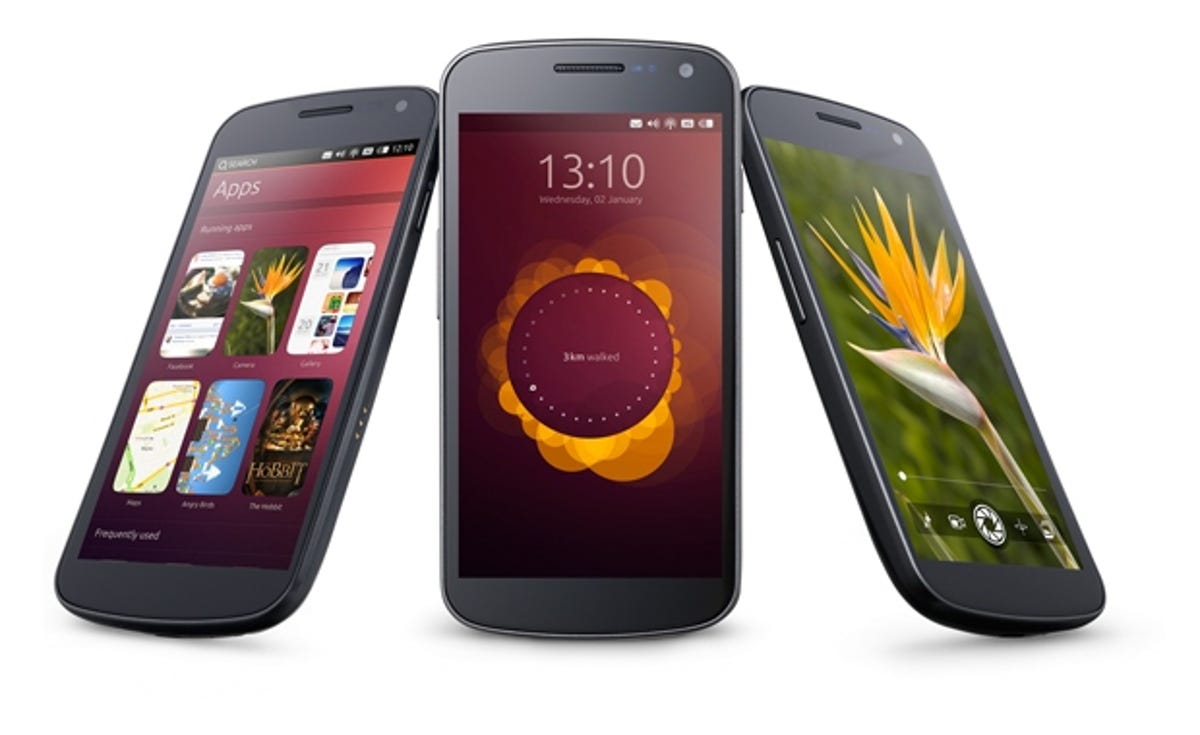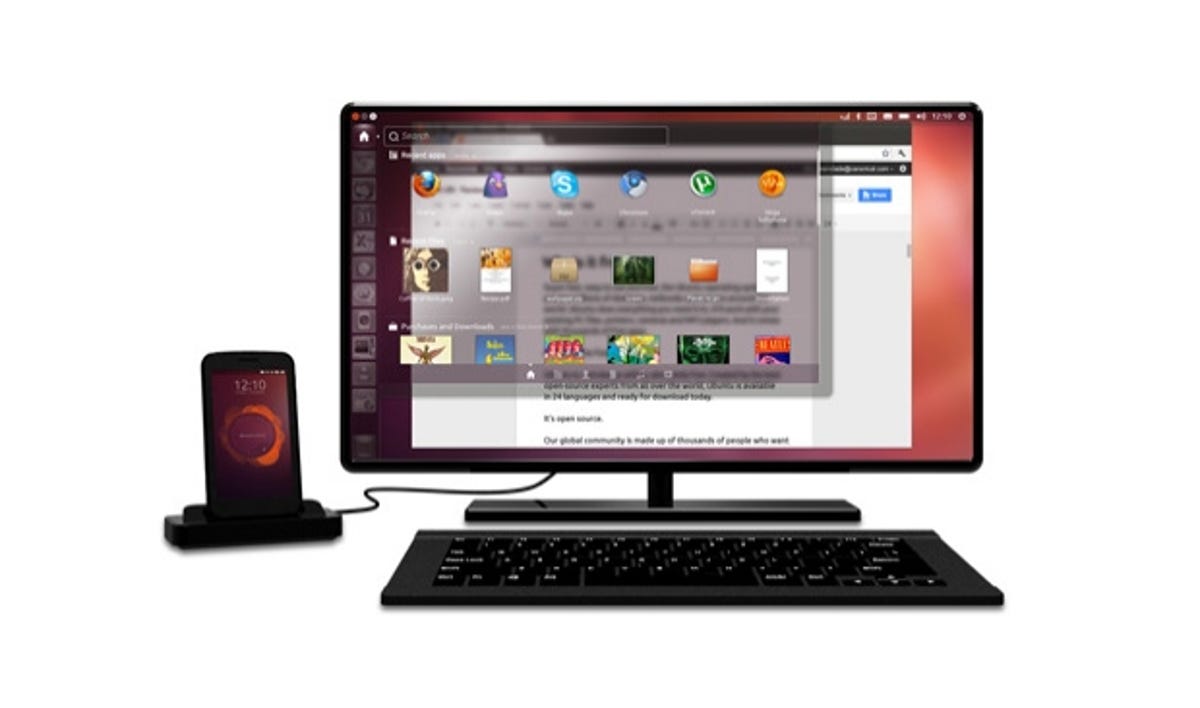
If the world of smart phone software wasn’t crowded and confusing enough, another contender has entered the ring. Canonical has brought its Ubuntu software to mobiles, promising a clean interface and optimisation for lower-end hardware. Sounds promising, but with zero support from manufacturers so far, Ubuntu is going to have a fight on its hands to establish its place in a busy market.
Ubuntu interface
Arguably the best thing about Ubuntu mobile is its interface. It’s clean, easy to read and offers a distinctive design that sets it apart from its Android or iOS rivals. Rather than being filled with a grid of static apps, iOS style, the homescreen displays recently opened apps and last-called contacts and swiping to the left or right displays recently played music.
Swiping in from the left displays a list of your favourite apps, allowing you to quickly switch between them, and swiping in from the right when you’re in an app brings up the last app you had open. This supposedly lets you quickly switch back to check information, but sadly there’s no way to immediately switch forwards again — you’ll need to navigate back to your homescreen, which limits this feature’s practicality.


There’s an Android-style notifications bar too, which allows you to control settings like screen brightness and connectivity. It requires you to swipe down from the top and then left or right to choose the setting to manipulate. At first glance it looked like a fairly elegant system, but watching a demonstration at Ubuntu’s press conference in London, it didn’t seem to work as well as it perhaps should.


The technician using the phone struggled to select the toolbar he wanted, and it would regularly disappear back out of sight before the task was completed. It might be early days for the software, but I couldn’t help but leave with the impression that it wasn’t quite as polished as it should be.
Apps
Ubuntu for desktop already benefits from an acceptable selection of apps, but these aren’t going to work on the mobile version. Instead, it will require developers to build new apps from scratch. Canonical was quick to point out the simplicity of building apps for Ubuntu and how many developers building apps for Android use Ubuntu for the coding — apparently meaning they’ll find it easier to make apps for mobile.
The complexity of building apps isn’t necessarily the biggest challenge however. The problem lies with Ubuntu’s lack of a large, established audience to sell the app to. It’s a problem facing even Microsoft — its Windows Phone 8 app store is growing steadily, but still pales into insignificance next to iOS or Android. With an even smaller audience buying apps, many developers can’t justify the expense in building it in the first place — something which will undoubtedly be a problem for Ubuntu.


On the plus side, Ubuntu allows web apps using HTML5 to run almost like a regular app would. You can lay an icon for it down on your homescreen as normal, and it’s even possible for it to use the phone’s notifications — an icon will pop up when you receive a Facebook message, for example. While this might help plug the holes in the app store for the essentials of Facebook and Twitter, hardcore app addicts — particularly, gamers — who want glossy new titles saved to their phone for offline use are unlikely to be satisfied.
Who’s it for?
Mark Shuttleworth, founder of Ubuntu, highlighted two main areas for Ubuntu mobile to target. The first is in lower-end smartphones, on which he promises a “great performance” from Ubuntu, and an ability to breathe new life into tired old phones. Indeed, its minimum hardware requirements are only a dual-core processor and 512MB of RAM — roughly what you’d find in the Samsung Galaxy S2 and far below quad-core brutes like the S3 or Note 2.
The Ubuntu demo I was shown was running on a Samsung Galaxy Nexus — the first and only phone the software will be available on — and results were mixed. For the most part, navigation seemed fairly swift, but there were a few times where noticeable stuttering and delay crept in. The Galaxy Nexus isn’t even a true ‘low-end’ phone, such as the ones Ubuntu claims the software is aimed at, so I’m not entirely convinced it’s going to offer the nippy performance claimed.
The second target area is what Ubuntu calls the ‘superphone’, and it’s this section of the market that is perhaps most innovative and exciting. Shuttleworth explained that the top-end smart phones (quad-core processor, 1-2GB of RAM) will be able to run as a regular phone, then dock with a screen and keyboard, acting as a desktop computer and providing a unified experience across both. The phone essentially becomes a single brain powering multiple devices.


For any professional who regularly has to jump between offices, plugging laptops into different screens each time they sit down this could be a valuable proposition. Rather than dragging multiple devices around all day, all your work files, contacts and app data can be stored on just your phone.
It’s a potentially handy tool and something that isn’t offered by its Android, iOS or Windows Phone 8 rivals, all of which use separate phone and desktop interfaces and, crucially, separate apps.
Manufacturer cooperation
Getting Ubuntu onto your phone, however, isn’t a simple case of downloading and installing as it is with the desktop version. It requires specific software to work with each individual phone, which means getting manufacturers and phone networks on board. Sadly, Mark Shuttleworth admitted that there is so far “no launch commitment” from any manufacturer or network.
At the moment, the only phone that will be able to use Ubuntu mobile is the Samsung Galaxy Nexus — a far step in terms of power from the ‘superphone’ section Ubuntu has its sights on. It will be possible to install Ubuntu onto existing phones, but it will require a considerable amount of tweaking to make it run on each model. Shuttleworth explained, “Where it’s straightforward, we will.”
While Ubuntu has worked with PC manufacturers such as Dell and Asus to have its software pre-installed on machines to sell in stores, working with phones is a different beast altogether. Not only does each phone require different software, but variations of the same device (3G or 4G, or regional variations) will require specific software changes.
It’s a big task and it’s part of the reason that Android software updates always take so long in turning up — the software has to be adjusted and rewritten so many times. Ubuntu is going to have a serious challenge on its hands convincing both manufacturers and phone networks to launch phones with the software preinstalled. Without such a commitment, the ‘superphone’ area Ubuntu is hoping to develop simply won’t exist.
When will it be available?
The first available download of Ubuntu mobile is scheduled to launch in the next couple of weeks. You’ll only be able to install it on the Samsung Galaxy Nexus so if you’re keen to give it a try it then head over to Amazon and grab a SIM-free handset.
Shuttleworth hopes to have Ubuntu pre-installed on handsets towards the end of this year or in early 2014, so there’s quite a long wait to see exactly how the software will run on the elite phones.
Outlook
Ubuntu’s mobile interface is neat and attractive. Its proposition of squeezing a decent performance out of more modest components is welcome and the ‘superphone’ plan of having a single device acting as both phone and computer is undeniably exciting. Sadly, it doesn’t offer enough over Android or iOS to tempt users to switch, and without the users, it’ll be tough to convince manufacturers to install it as standard on high-end phones.
Ubuntu will be showing off more of the new software at CES in Las Vegas next week, so keep your eyes peeled on our dedicated CES site for all the latest news from the show floor.



